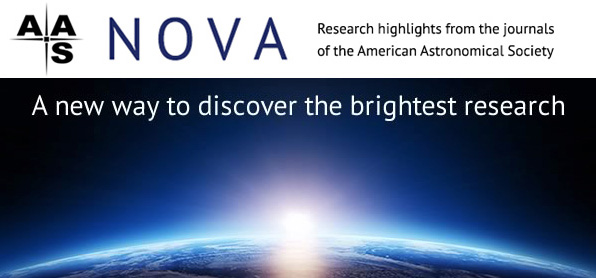Highlights from AAS Nova: 19 March - 1 April 2017

Susanna Kohler American Astronomical Society (AAS)
AAS Nova provides brief highlights of recently published articles from the AAS journals, i.e., The Astronomical Journal (AJ) and The Astrophysical Journal (ApJ), ApJ Letters, and ApJ Supplements. The website's intent is to gain broader exposure for AAS authors and to provide astronomy researchers and enthusiasts with summaries of recent, interesting research across a wide range of astronomical fields.
The following are the AAS Nova highlights from the past two weeks; follow the links to read more, or visit the AAS Nova webpage for more posts.
31 March 2017
An Exo-Venus in the Solar Neighborhood
Why is Earth hospitable to life and Venus not? Kepler-1649b, a newly discovered exo-Venus, may help us figure this out!
29 March 2017
Counting Rogue Asteroids and Comets
How many comets, asteroids, and planetary bodies are floating through interstellar space, not gravitationally bound to any solar system?
28 March 2017
Same Ol’ Same Ol’? Galaxy Clusters Across Cosmic Time
Astrobites reports on X-ray studies of galaxy clusters, which tell us how the extremely hot gas is distributed within these gigantic structures.
27 March 2017
Observations from Sunrise
In 2013, a team of scientists gathered in Sweden to launch a balloon carrying the largest solar telescope to leave Earth. Now they’re sharing what they learned from the flight!
24 March 2017
Challenging the Model for Galactic Bulges
What determines how much mass will end up in the bulge and the black hole at the center of a Milky-Way-like galaxy?
22 March 2017
AAS Publishing News: Now You Can Raise Zombie Astrophotos
Looking for something fun and rewarding to do in your spare time? A new citizen science project has been added to the Zooniverse platform: Astronomy Rewind.
21 March 2017
Super Star Clusters Far Far Away
Astrobites reports on super star clusters discovered using gravitational lensing.
20 March 2017
Featured Image: Experimental Simulation of Melting Meteoroids
Ever wonder what experimental astronomy looks like? Some days, it looks like this piece of agrillite in a wind tunnel.


